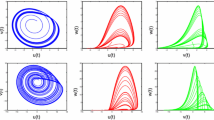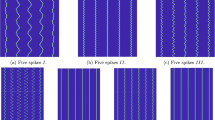Abstract
Many chemical systems exhibit a range of patterns, a noticeable and interesting class of numerical patterns that arise in autocatalytic reactions which changes with increasing spatial domains. In this paper, autocatalytic spatiotemporal patterns were demonstrated using the system of chemical species modeled with the time-fractional Caputo derivatives of subdiffusive orders. It is not new that a spectral algorithm with its entire nature is more accurate when compared with a finite-difference scheme to solve a range of integer and non-integer order time partial differential equations. This is because the Fourier spectral techniques have the upper hand on high-order spectral accuracy, and are computationally efficient. Hence, it is regarded as the best approach to existing lower-order methods for integrating the second-order partial derivatives in space. This motivates the present study to explore the usefulness of Fourier spectral methods in resolving and obtaining complex Turing patterns arising from nonlinear fractional autocatalytic reaction-diffusion problems in high dimensions. The autocatalysis model was examines for linear stability in an attempt to obtain the correct choice of parameters that are likely to lead to the formation of new complex turing-like patterns. Numerical experiments in the 2D lead to a striking range of patterns arising from catalytic reactions of fractional-order labyrinthine pattern-like structures. Analysis of pattern formation was also extended to 3D dynamics to obtain a new set of patterns like a star-, cyclic-, diamond-like, and the emergence of apple-shaped structures, which are greatly influenced by either the choice parameters that are involved or that of the initial conditions.

















Similar content being viewed by others
Explore related subjects
Discover the latest articles, news and stories from top researchers in related subjects.Data availability statements
Data sharing not applicable to this article as no datasets were generated or analyzed during the current study.
References
Alqhtani M, Owolabi KM, Saad KM, Pindza E (2022) Efficient numerical techniques for computing the Riesz fractional-order reaction-diffusion models arising in biology. Chaos Solitons Fractals 161:112394
Alqhtani M, Owolabi KM, Saad KM (2022) Spatiotemporal (target) patterns in sub-diffusive predator-prey system with the Caputo operator. Chaos Solitons Fractals 160:112267
Ana X, Liu F, Zheng M, Anh VV, Turner IW (2021) A space-time spectral method for time-fractional Black-Scholes equation. Appl Numer Math 165:152–166
Animasaun IL (2016) 47nm alumina-water nanofluid flow within boundary layer formed on upper horizontal surface of paraboloid of revolution in the presence of quartic autocatalysis chemical reaction. Alex Eng J 55:2375–2389
Ascher UM, Ruth SJ, Wetton BTR (1995) Implicit-explicit methods for time-dependent partial differential equations. SIAM J Numer Anal 32:797–823
Ascher UM, Ruth SJ, Spiteri RJ (1997) Implicit-explicit Runge-Kutta methods for time-dependent partial differential equations. Appl Numer Math 25:151–167
Atangana A (2016) Derivative with a New Parameter: Theory. Academic Press, NY
Atangana A (2017) Fractional operators with constant and variable order with application to geo-hydrology. Academic Press, NY
Atangana A, Owolabi KM (2018) New numerical approach for fractional differential equations. Math Modell Nat Phenom 13(3):21. https://doi.org/10.1051/mmnp/2018010
Barrio RA, Varea C, Aragon JL, Maini PK (1999) A two-dimensional numerical study of spatial pPattern formation in interacting Turing systems. Bull Math Biol 61:483–505
Blackmond D (2009) An examination of the role of autocatalytic cycles in the chemistry of proposed primordial reactions. Angew Chem 48:386–390
Boyd JP (2001) Chebyshev and fourier spectral methods. Dover, NY
Calvo M, Palencia C (2006) A class of explicit multi-step exponential integrators for semi-linear problems. Numer Math 102:367–381
Chen W-C (2008) Nonlinear dynamics and chaos in a fractional-order financial system. Chaos Solitons Fractals 36:1305–1314
Cox SM, Matthews PC (2002) Exponential time differencing for stiff systems. J Comput Phys 176:430–455
Diethelm K, Freed AD (1999) On the solution of nonlinear fractional order differential equations used in the modelling of viscoplasticity. In: Scientific computing in chemical engineering II: computational fluid dynamics, reaction engineering and molecular properties. Springer Verlag, Heidelberg, pp 217–224
Ervin VJ, Roop JP (2006) Variational formulation for the stationary fractional advection dispersion equation. Numer Methods Partial Differ Eq 22:558–576
Ervin VJ, Heuer N, Roop JP (2018) Regularity of the solution to 1-D fractional order diffusion equations. Math Comput 87:2273–2294
Fornberg B, Driscoll TA (1999) A fast spectral algorithm for nonlinear wave equations with linear dispersion. J Comput Phys 155:456–467
Gao G, Sun Z (2011) A compact finite difference scheme for the fractional sub-diffusion equations. J Comput Phys 230:586–595
Gorenflo R, Mainardi F, Scalas E, Raberto M (2001) Fractional calculus and continuous-time finance. III. The diffusion limit, Math. Finance (Konstanz, 2000) 171–180
Hochbruck M, Ostermann A (2005) Exponential Runge-Kutta methods for parabolic problems. Appl Numer Math 53:323–339
Hochbruck M, Ostermann A (2005) Explicit exponential Runge-Kutta methods for semilinear parabolic problems. SIAM J Numer Anal 43:1069–1090
Hochbruck, Ostermann A (2010) Exponential integrators. Acta Numer 19:209–286
Hochbruck M, Ostermann A (2011) Exponential multistep methods of Adams-type. BIT Numer Math 51:889–908
Karig D, Martini KM, Lu T, Weiss R (2018) Stochastic Turing patterns in a synthetic bacterial population. PNAS 115:6572–6577
Kassam AK, Trefethen LN (2005) Fourth-order time-stepping for stiff PDEs. SIAM J Sci Comput 26:1214–1233
Lacitignola D, Sgura I, Bozzini B (2021) Turing-Hopf patterns in a morphochemical model for electrodeposition with cross-diffusion. Appl Eng Sci 5:100034
Landge AN, Jordan BM, Diego X, Müller P (2020) Pattern formation mechanisms of self-organizing reaction-diffusion systems. Dev Biol 460:2–11
Li X, Xu C (2009) A space-time spectral method for the time fractional diffusion equation. SIAM J Numer Anal 47(3):2108–2131
Li X, Xu C (2010) Existence and uniqueness of the weak solution of the space-time fractional diffusion equation and a spectral method approximation, Commun. Comput Phys 8:1016–1051
Liu F, Anh V, Turner I (2004) Numerical solution of the space fractional Fokker-Planck equation. J Comput Appl Math 166:209–219
Makinde OD, Animasaun IL (2016) Bioconvection in MHD nanofluid flow with nonlinear thermal radiation and quartic autocatalysis chemical reaction past an upper surface of a paraboloid of revolution. Int J Thermal Sci 109:159–171
Makinde OD, Animasaun IL (2016) Thermophoresis and Brownian motion effects on MHD bioconvection of nanofluid with nonlinear thermal radiation and quartic chemical reaction past an upper horizontal surface of a paraboloid of revolution. J Mol Liquids 221:733–743
Carpinteri A, Mainardi F (1997) Fractals Fract Calc Contin Mech. Springer-Verlag, Wien
Meerschaert MM, Tadjeran C (2004) Finite difference approximations for fractional advection-dispersion flow equations. J Comput Appl Math 172:65–77
Metzler R, Klafter J (2000) The random walk’s guide to anomalous diffusion: a fractional dynamics approach. Phys Rep 339(1):1–77
Metler R, Klafter J (2004) The restaurant at the end of random walk: recent developments in the description of anomalous transport by fractional dynamics. J Phys A 37:R161–R208
Miller KS, Ross B (1993) An introduction to the fractional calculus and fractional differential equations. Wiley, Hoboken
Moskon M, Komac R, Zimic N et al (2021) Distributed biological computation: from oscillators, logic gates and switches to a multicellular processor and neural computing applications. Neural Comput Appl 33:8923–8938
Müller P, El-Sherif E (2020) A systems-level view of pattern formation mechanisms in development. Dev Biol 460:1. https://doi.org/10.1016/j.ydbio.2019.10.034
Murray JD (2002) Mathematical biology I: an introduction. Springer-Verlag, NY
Murray JD (2003) Mathematical biology II: spatial models and biomedical applications. Springer-Verlag, Berlin
Oldham KB, Spanier J (1974) The fractional calculus. Academic Press, NY
Ostwald W (1912) Outlines of general chemistry (trad. Taylor, W.W.), chap. XI.1. Macmillan and co, NY, p. 301
Owolabi KM, Atangana A (2016) Numerical solution of fractional-in-space nonlinear Schrödinger equation with the Riesz fractional derivative. Eur Phys J Plus 131:335
Owolabi KM (2017) Robust and adaptive techniques for numerical simulation of nonlinear partial differential equations of fractional order. Commun Nonlinear Sci Numer Simul 44:304–317
Owolabi KM (2018) Mathematical analysis and numerical simulation of chaotic non-integer order differential systems with Riemann-Liouville derivative. Numer Methods Partial Differ Eq 34:274–95
Owolabi KM, Atangana A (2019) Higher-order solvers for space-fractional differential equations with Riesz derivative. Discret Contin Dynamic Syst Ser S 12:567–590
Owolabi KM (2020) Numerical simulation of fractional-order reaction-diffusion equations with the Riesz and Caputo derivatives. Neural Comput Appl 32:4093–4104
Owolabi KM, Baleanu D (2021) Emergent patterns in diffusive Turing-like systems with fractional-order operator. Neural Comput Appl 33:12703–12720
Owolabi KM (2021) Computational analysis of different Pseudoplatystoma species patterns the Caputo-Fabrizio derivative. Chaos Solitons Fractals 144:110675
Alqhtani M, Owolabi KM, Saad KM (2022) Spatiotemporal (target) patterns in sub-diffusive predator-prey system with the Caputo operator. Chaos Solitons Fractals 160:112267
Alqhtani M, Owolabi KM, Saad KM, Pindza E (2022) Efficient numerical techniques for computing the Riesz fractional-order reaction-diffusion models arising in biology. Chaos Solitons Fractals 161:112394
Pindza E, Owolabi KM (2016) Fourier spectral method for higher order space fractional reaction-diffusion equations. Commun Nonlinear Sci Numer Simul 40:112–128
Plasson R, Kondepudi DK, Bersini H, Commeyras A, Asakura K (2007) Emergence of homochirality in far-from-equilibrium systems: mechanisms and role in prebiotic chemistry. Chirality 19:589–600
Plasson R (2008) Comment on re-examination of reversibility in reaction models for the spontaneous emergence of homochirality. J Phys Chem B 112:9550–9552
Podlubny I (1999) Fractional Differential Equations. Academic Press, NY
Samko SG, Kilbas AA, Marichev OI (1993) Fractional integrals and derivatives: theory and applications. Gordon and Breach, Amsterdam
Scalas E, Gorenflo R, Mainardi F (2000) Fractional calculus and continuous-time finance. Phys A Stat Mech Appl 284(1–4):376–384
Schiesser WE (1991) Numerical method of lines integration of partial differential equations. Academic Press, San Diego
Schisser WE, Griffiths GW (2009) A compendium of partial differential equation models: method of lines analysis with Matlab. Cambridge University Press, Cambridge
Soai K, Shibata T, Morioka H, Choji K (1995) Asymmetric autocatalysis and amplification of enantiomeric excess of a chiral molecule. Nature 378:767–768
Trefethen LN (1996) Finite difference and spectral methods for ordinary and partial differential equations. Upson Hall Cornell University Ithaca, NY
Trefethen LN (2000) Spectral methods in MATLAB. SIAM, Philadelphia
Trefethen LN, Embere M (2005) Spectra and pseudospectra: the behavior of nonnormal matrices and operators. Princeton University Press, New Jersey
Vittadello ST, Leyshon T, Schnoerr D, Stumpf MPH (2021) Turing pattern design principles and their robustness. Phil Trans R Soc A 379:20200272. https://doi.org/10.1098/rsta.2020.0272
Yuste SB, Acedo L, Lindenberg K (2004) Reaction front in an \(A + B\rightarrow C\) reaction-subdiffusion process. Phys Rev E 69(3):036126
Zaslavsky GM (2002) Chaos, fractional kinetics, and anomalous transport. Phys Rep 371(6):461–580
Zhang H, Jiang X, Wang C, Fan W (2018) Galerkin-Legendre spectral schemes for nonlinear space fractional Schrödinger equation. Numer. Algorithms 79:337–356
Zhang H, Jiang X, Yang X (2018) A time-space spectral method for the time-space fractional Fokker-Planck equation and its inverse problem. Appl Math Comput 320:302–318
Zhao M, Wang H (2019) Fast finite difference methods for space-time fractional partial differential equations in three space dimensions with nonlocal boundary conditions. Appl Numer Math 145:411–428
Zheng M, Liu F, Turner I, Anh V (2015) A novel high order space-time spectral method for the time fractional Fokker-Planck equation. SIAM J Comput 37(2):A701–A724
Zheng M, Liu F, Anh V, Turner I (2016) A high-order spectral method for the multi-term time-fractional diffusion equations. Appl Math Model 40(7–8):4970–4985
Author information
Authors and Affiliations
Corresponding author
Ethics declarations
Conflict of interest
The authors have no competing interests.
Additional information
Publisher's Note
Springer Nature remains neutral with regard to jurisdictional claims in published maps and institutional affiliations.
Rights and permissions
Springer Nature or its licensor (e.g. a society or other partner) holds exclusive rights to this article under a publishing agreement with the author(s) or other rightsholder(s); author self-archiving of the accepted manuscript version of this article is solely governed by the terms of such publishing agreement and applicable law.
About this article
Cite this article
Owolabi, K.M., Agarwal, R.P., Pindza, E. et al. Complex Turing patterns in chaotic dynamics of autocatalytic reactions with the Caputo fractional derivative. Neural Comput & Applic 35, 11309–11335 (2023). https://doi.org/10.1007/s00521-023-08298-2
Received:
Accepted:
Published:
Issue Date:
DOI: https://doi.org/10.1007/s00521-023-08298-2




